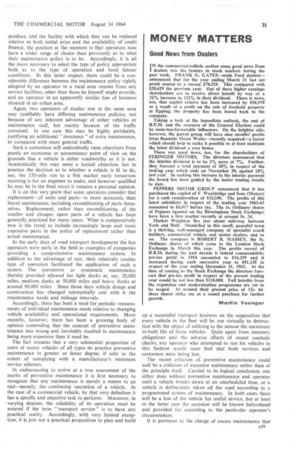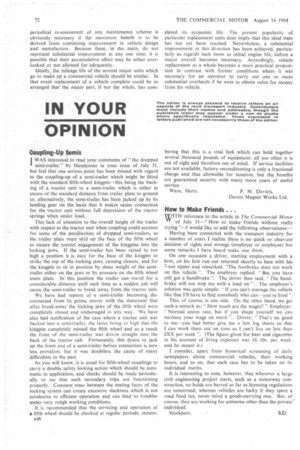Maintenance and Vehicle Availability
Page 72

Page 73

Page 74

If you've noticed an error in this article please click here to report it so we can fix it.
THE rapid development of road transport during the past 50 years has been increasingly highlighted in recent official reports. From 1952 to 1962 the amount of inland goods transport sent by road increased from 46 to 68 per cent of the total. Concurrently, the number of goods vehicles increased from around 1m. to lint., and the effect of this increase is daily self-evident on the roadg. themselves.
Not so self-evident are subsidiary changes allied to these basic developments. Because transport is a service industry many of these changes stem from meeting changes which have concurrently taken place in other industries. But, apart from specific changes in any particular industry, there has been an overall speeding-up of the tempo in industry. This, in turn, has created or expanded the need for a more frequent transport service, both as regards the incoming basic material and collection of the finished product. , This trend has been favourable to the expansion of road transport because of its inherent flexibility and ability to operate to a strict timetable.
Coupled with this increasing tempo has been an expansion in output generally. Consequently, this has increased the demand on labour, whilst the national average for weekly earnings continues to rise.
Whilst several of these factors are in the road transport operator's favour, they have worked adversely in respect of maintenance of vehicles. On a national level, there is an increasing number of commercial vehicles to be serviced and maintained, whilst the supply of skilled labour becomes more limited, or even declines_ As a subsidiary development, the extent of servicing facilities—whether supplied by public garages or the operator himself—should have kept pace with the increase in the total number of vehicles. This has not occurred, but the full effect of this omission has not been felt because of the continuing improvement in the reliability of vehicles generally and the increasing availability of exchange units. Strictly speaking, maintenance is not eliminated by such a policy, but rather transferred from being a responsibility of the operator to that of the manufacturer or distributor. Nevertheless, the results currently being obtained from. the Ministry of Transport roadside checks are clear evidence that adequate maintenance is not always being provided.
Old habits die hard, and in this respect the ability to undertake any repair at any time of the day or night to any vehicle in the fleet was traditionally considered the hallmark of a competent road transport operator. Whilst in large fleets such a policy can still prove economic and worthwhile, it is becoming increasingly uneconomic for other operators to apply and, indeed, may soon prove impossible because of the shortage or actual non • availability of skilled labour.
Closely allied to the subject of vehicle maintenance is that of vehicle replacement which, translated into costing terms, is the relation between maintenance costs and depreciation. Alongside the developments already mentioned, including the improved reliability of vehicles and equipment, has been the rising range of quantity-produced commercial vehicles at competitive prices. As a result, more operators now have the choice between selecting this type of vehicle and replacing it relatively frequently,. or purchasing a more robust vehicle for operation over an extended period. Quite apart from this aspect of vehicle replacement, however, the ultimate decision will depend on other factors, including the type of work to be undertaken, for which, in many cases, the more robust vehicle would be essential if a reliable service was to be provided.
In other cases this greater availability of quantityproduced vehicles .does have direct bearing on an operator's maintenance policy. Looking to the future— with automation in the manufacturing industry—it might be claimed that the man in overalls with a spanner in his hand will become an anachronism. As previously mentioned, manufacturers are already undertaking operators' maintenance to the extent of providing exchange reconditioned engines and other units. This they can do competitively because of their mass-production methods. It is conceivable that with the advent of full automation the manufacturer himself will find it cheaper to produce a new unit than to recondition one, despite the economic advantages he now has in so doing compared with the facilities available to the operator.
Whatever .the ultimate development, both as regards the types of vehicles a fully automated motor industry may produce, and the facility with which they can be replaced relative to both initial price and the availability of credit finance, the position at the moment is that operators now have a wider range of choice than previously as to what their maintenance policy is to be. Accordingly, it is all the more necessary to select the type of policy appropriate both as to the type of operation and local, labour conditions. In this latter respect, there could be a considerable difference between the maintenance policy rightly adopted by an operator in a rural area remote, from any service facilities, other than those he himself might provide, and an operator in an apparentty similar line of business situated in an urban area.
Again, two operators of similar size in the same area may justifiably have differing maintenance policies, not because of any inherent advantage of either vehicles or maintenance staff, but mainly because of the traffic conveyed. In one case this' may be highly perishable, justifying an additional " insurance " of extra maintenance, as compared with more general traffic.
Such a contention will undoubtedly raise objections from purely an economic or accountancy point of view on the grounds that -a vehicle is either roadworthy or it is not. Academically this may seem a logical objection, but in practice the decision as to whether a vehicle is fit to do, say, the 150-mile run to a fish market early tomorrow morning is for an engineer to make, and however qualified he may be in the final resort it remains a personal opinion.
It is on this very point that some operators considei that replacement—of units ,and parts—is more economic than literal maintenance, including reconditioning of parts themselves. 'Replacement, rather than reconditioning, of the smaller and cheaper spare parts of a vehicle has been generally practised for many years. What is coniparatively new is the trend to include increasingly large and more expensive parts in the policy of replacement rather than actual maintenance.
In the early days of road transport development the bus operators were early in the field as examples of companies providing a comprehensive maintenance system. In addition to the advantage of size, their relatively routine type of operation facilitated the application of such a system. The preventive or systematic maintenance thereby provided allowed for light docks at, say, 20,000 miles, medium docks at 50,000 miles and heavy docks at around 90,000 miles Since those days vehicle design and construction has changed substantially and with it the maintenance needs and mileage intervals.
Accordingly, there has been a need for periodic reassessments of individual maintenance needs relative to changing vehicle availability and operational requirements. More recently, however, there has been a growing body of opinion contending that the concept of preventive maintenance was wrong and inevitably resulted in maintenance being more expensive than it need be.
The fact remains that a very substantial proportion of users of motor vehicles of all types do practice preventive maintenance in greater or lesser degree, if only to the extent of complying with a manufacturer's minimum service schemes.
In endeavouring to arrive at a true assessment of the merits of preventive maintenance it is first necessary to recognize that any maintenance is merely a means to an end—namely, the continuing operation of a vehicle. In the case of a commercial vehicle, by that very definition it has a specific and objective task to perform. Moreover, in varying degrees, the reliability of its operation must be assured if the term "transport service " is to have any practical reality. Accordingly, with very limited exception, it is just not a practical proposition to plan and build up a successful transport business on the supposition that every vehicle in the fleet will be run virtually to destruction with the object of utilizing to the utmost the maximum in-built life of those vehicles. Quite apart from statutory obligations and the adverse effects of recent roadside checks, any operator who attempted to run his vehicles in this fashion would soon find that both services and customers were being lost.
The recent criticism of_ preventive maintenance could well be a criticism of excessive maititenance rather than of the principle itself. Carried to its logical conclusion, one either does without preventive maintenance and operates
until a vehicle breaks down at an unscheduled time, or a vehicle is deliberately taken off the road according to a programmed system of maintenance. In both cases there
will be a loss of the vehicle for useful service, but at least
in the latter case the occasion will be known beforehand and provided for according to the particular operator's circumstances.
It is pertinent to the charge of excess maintenance that periodical re-assessment of any maintenance scheme is obviously necessary if the maximum benefit is to be derived from continuing improvement in vehicle design and manufacture. Because these, in the main, do not represent substantial improvement at any one time, it is possible that their accumulative effect may be either overlooked or not allowed for adequately.
Ideally, the mileage life of the several major units which go to make up a commercial vehicle should be similar. In that event replacement of a vehicle complete could be so arranged that the major part, if not the whole, has corn
pitted its economic life. The present popularity of particular replacement units does imply that this ideal state has not yet been reached. Nevertheless, a substantial improvement in this dicection has been achieved, particularly as regards such items as initial engine life, before a major overall becomes necessary. Accordingly, vehicle replacement as a whole becomes a more practical proposition in contrast with former conditions where it was necessary for an operator to carry out one or more substantial overhauls if he were to obtain value for money from his vehicle.




















































































































